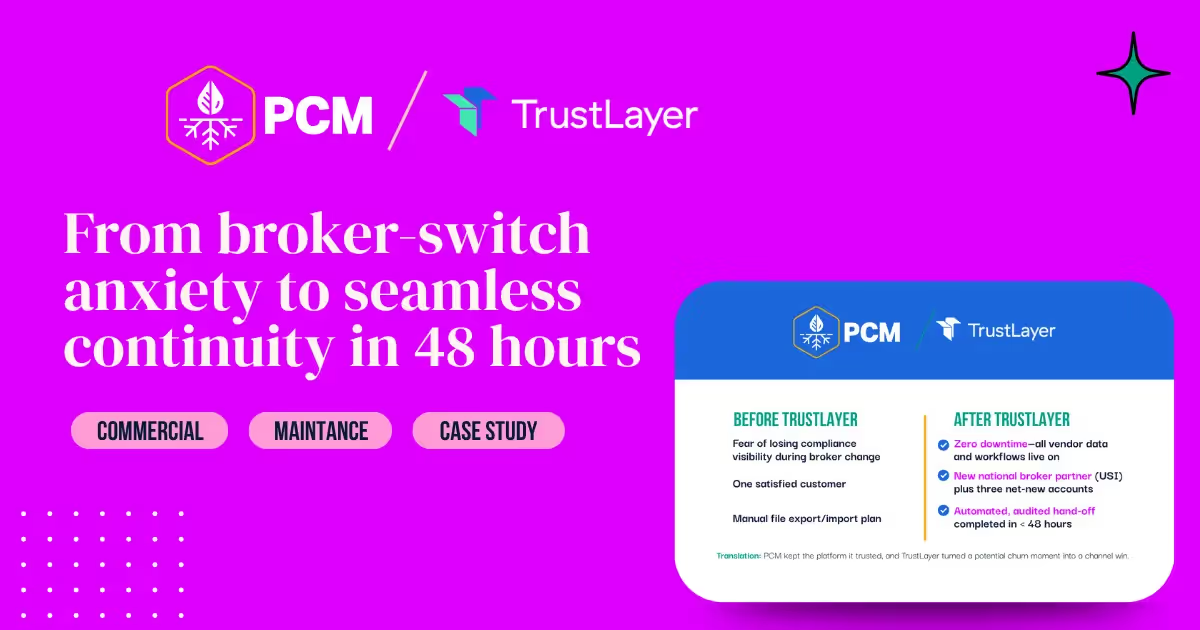The Contractor's Guide to Certificates of Insurance Management

In the world of contracting business, managing risk is of utmost importance. One crucial aspect of risk management is ensuring that contractors have adequate insurance coverage in place. This is where Certificates of Insurance (COIs) come into play. Understanding the basics of COIs and efficiently managing them is vital for contractors to protect themselves and their business interests. In this comprehensive guide, we will explore everything you need to know about Certificates of Insurance and how to effectively manage them.
Understanding the Basics of Certificates of Insurance
A Certificate of Insurance is a document that serves as proof of insurance coverage for a specific period. It summarizes the key details of an insurance policy and provides evidence that the policyholder has the necessary insurance protections. COIs are commonly used in the contracting industry to verify that contractors and subcontractors have insurance coverage that meets the requirements set forth in their contracts.
When it comes to the contracting business, Certificates of Insurance play a crucial role in protecting businesses from liability and mitigating potential risks. They provide reassurance to clients and business partners that contractors have the appropriate insurance coverage to handle potential damages or claims that may arise during the course of a project. Without proper insurance coverage, contractors could face potential lawsuits, financial loss, and damage to their reputation.
Now, let's dive deeper into the importance of Certificates of Insurance in the contracting industry. One of the key reasons why COIs are essential is that they help establish trust and credibility between contractors and clients. When a client hires a contractor, they want to ensure that the contractor has the necessary insurance coverage to protect both parties in case of any unforeseen events or accidents.
Imagine a scenario where a contractor is hired to renovate a client's property. During the renovation process, a worker accidentally damages a valuable antique piece. Without proper insurance coverage, the contractor would be personally liable for the cost of repairing or replacing the damaged item. However, if the contractor has a Certificate of Insurance that includes liability coverage, the insurance company would step in to cover the costs, protecting both the contractor and the client from financial loss.
Moreover, Certificates of Insurance also serve as a risk management tool for contractors. By having the appropriate insurance coverage, contractors can safeguard their business from potential lawsuits and claims. For example, if a worker gets injured on a construction site, the contractor's workers' compensation insurance would cover the medical expenses and lost wages, preventing the injured worker from suing the contractor for negligence.
Additionally, Certificates of Insurance help contractors comply with contractual requirements. Many contracts require contractors to maintain specific types and amounts of insurance coverage to protect all parties involved. By providing a Certificate of Insurance that meets these requirements, contractors can demonstrate their commitment to fulfilling their contractual obligations and ensure that they are in compliance with the terms of the agreement.
In conclusion, Certificates of Insurance are vital documents in the contracting industry. They provide proof of insurance coverage, establish trust and credibility, mitigate risks, and help contractors comply with contractual requirements. By having the appropriate insurance protections in place, contractors can protect themselves, their clients, and their business from potential liabilities and financial loss.
Key Elements of a Certificate of Insurance
A well-prepared Certificate of Insurance is a crucial document that provides important information about an individual or company's insurance coverage. It serves as proof that the policyholder has obtained insurance and can provide financial protection in the event of a claim. While the basic elements of a Certificate of Insurance include policyholder information, insurer details, and coverage limits and types, there are additional details that can enhance the comprehensiveness of this document.
Policyholder Information
When it comes to policyholder information, accuracy and completeness are paramount. In addition to the contractor's name, address, and contact information, it is beneficial to include any relevant identification numbers, such as a tax identification number or a business registration number. This additional information can help streamline the verification process and ensure that the certificate is easily identifiable.
Furthermore, including a brief description of the policyholder's business activities can provide context and help the recipient understand the nature of the insured operations. Whether it's construction, consulting, or any other industry, this detail can add depth to the certificate and facilitate a better understanding of the insured risks.
Insurer Details
While stating the name of the insurance company providing coverage is essential, it can be beneficial to provide additional information about the insurer. This could include a brief overview of the insurer's history, reputation, and financial strength. Highlighting the insurer's credentials can instill confidence in the recipient and demonstrate that the policyholder has chosen a reputable and reliable insurance provider.
In addition to the policy number and effective dates, it may be useful to include information about the insurance agent or broker involved in securing the coverage. This can provide a point of contact for any inquiries or clarifications regarding the policy, further enhancing the transparency and accessibility of the insurance arrangements.
Coverage Limits and Types
While specifying the types of coverage obtained is important, expanding on each coverage type can provide a more comprehensive understanding of the policyholder's insurance program. For instance, in the case of general liability insurance, it can be helpful to outline the specific risks covered, such as bodily injury, property damage, or personal and advertising injury. This level of detail can help the recipient assess the adequacy of the coverage and identify any potential gaps.
Additionally, explaining the coverage limits in more depth can provide valuable insights. This could involve clarifying whether the limits are per occurrence, aggregate, or a combination of both. It may also be beneficial to provide examples of hypothetical claim scenarios and how the coverage limits would apply in each case. This level of detail can help the recipient grasp the financial protection provided by the insurance policy and make informed decisions based on their risk exposure.
By expanding on these key elements, a Certificate of Insurance can become a more informative and valuable document. It not only serves as proof of insurance coverage but also provides a comprehensive overview of the policyholder's insurance arrangements, facilitating better understanding and decision-making for all parties involved.
The Process of Obtaining a Certificate of Insurance
Obtaining a Certificate of Insurance is typically a straightforward process that involves a series of steps. Contractors who require this certificate must contact their insurance agent or broker to initiate the application process. The insurance agent or broker will then guide them through the necessary procedures and requirements.
Steps to Apply for a Certificate of Insurance
When applying for a Certificate of Insurance, contractors need to provide their insurance agent or broker with specific details related to the project. These details typically include the project name, location, and insurance requirements. By providing accurate and comprehensive information, contractors can ensure that the certificate is tailored to their specific needs.
Once the insurance agent or broker has received all the necessary details, they will begin the process of preparing the Certificate of Insurance. This involves reviewing the coverage requirements and selecting the appropriate insurance policies to meet those requirements. The insurance professional will then compile all the relevant information into the certificate, ensuring that it accurately reflects the contractor's insurance coverage.
After the Certificate of Insurance has been prepared, it will be issued to the contractor. This document serves as proof of the contractor's insurance coverage and is often required by clients or project owners before work can commence. It provides assurance that the contractor has the necessary insurance protection in place to mitigate potential risks and liabilities.
Understanding the Time Frame for Issuance
It is crucial for contractors to understand the time frame involved in obtaining a Certificate of Insurance. The length of time it takes to obtain the certificate can vary depending on several factors, including the insurance provider and the complexity of the coverage required.
In some cases, the issuance of a Certificate of Insurance can be a relatively quick process, taking only a few days. This is especially true for contractors who have an established relationship with their insurance agent or broker, as the necessary information may already be readily available.
However, in more complex situations where specialized coverage is required, it may take longer to obtain the certificate. This could be due to the need for additional underwriting or the involvement of multiple insurance providers to meet specific coverage requirements. In such cases, it is prudent for contractors to plan ahead and allow sufficient time to acquire the necessary documentation before commencing any contract work.
By understanding the time frame for issuance, contractors can effectively manage their project timelines and ensure that they have the required insurance coverage in place when needed. This proactive approach helps to minimize potential delays and ensures that contractors can proceed with their work confidently and in compliance with contractual obligations.
Managing Your Certificates of Insurance
Organizing and Storing Certificates
Efficiently organizing and storing Certificates of Insurance is essential for contractors. Keeping track of multiple certificates can be challenging, especially when managing ongoing projects. Consider implementing a digital document management system that allows you to easily access and store certificates in one centralized location. This ensures that you can quickly locate and provide the necessary documentation when required.
When organizing your certificates, it is helpful to categorize them based on project type or client. This way, you can easily retrieve the relevant certificate when needed. Additionally, consider creating a backup system to protect your certificates from loss or damage. This can include regularly backing up your digital files and keeping physical copies in a secure location.
Another important aspect of managing your certificates is maintaining a comprehensive record of each certificate's details. This includes information such as the insurance provider, policy number, coverage limits, and expiration dates. By keeping this information up-to-date and easily accessible, you can effectively track the status of your certificates and ensure that they are renewed in a timely manner.
Renewal and Updates of Certificates
Regularly reviewing and renewing Certificates of Insurance is crucial to maintain adequate coverage. Policies may expire or need updates, requiring contractors to obtain new certificates. It is important to work closely with your insurance agent or broker to ensure that your coverage aligns with your business needs and that all necessary certificates are up-to-date.
When it comes to renewal, it is advisable to start the process well in advance of the expiration date. This allows ample time to review your current coverage, assess any changes in your business operations, and make any necessary adjustments. By proactively managing the renewal process, you can avoid any gaps in coverage that may leave you exposed to potential risks.
Additionally, it is essential to stay informed about any changes in insurance requirements or regulations that may affect your certificates. This can include updates in coverage limits, additional endorsements, or changes in the types of insurance required for specific projects. By staying up-to-date with these changes, you can ensure that your certificates meet all necessary requirements and comply with industry standards.
Furthermore, it is important to communicate with your insurance agent or broker regularly to discuss any updates or changes in your business operations. This can include adding new services, expanding into different markets, or taking on larger projects. By keeping your insurance provider informed, they can help you assess any potential risks and make the necessary adjustments to your coverage.
In conclusion, effectively managing your Certificates of Insurance involves organizing and storing them in a centralized location, regularly reviewing and renewing them, and staying informed about any updates or changes in insurance requirements. By implementing these strategies, you can ensure that your certificates are up-to-date, easily accessible, and provide the necessary coverage to protect your business.
Common Mistakes in Certificate of Insurance Management
Avoiding Inadequate Coverage
One common mistake contractors make is assuming they have adequate insurance coverage when, in fact, they do not. It is essential to thoroughly review policy terms, limits, and exclusions to avoid potential coverage gaps. Working closely with a knowledgeable insurance professional can help ensure that you have the appropriate coverage to protect your business interests.
Neglecting Timely Renewals
Another common issue is neglecting to renew Certificates of Insurance on time. Failure to renew a policy can leave contractors without coverage, putting their business at risk. To prevent any lapses in coverage, implement a reminder system or work with an insurance partner who can proactively manage the renewal process.
In conclusion, Certificates of Insurance are a vital aspect of managing risk in the contracting industry. Understanding the basics of COIs and effectively managing them is essential for contractors to protect themselves and their business interests. By following the guidelines outlined in this comprehensive guide, contractors can navigate the complexities of Certificate of Insurance management with confidence. Remember, the right insurance partner, such as TrustLayer, can provide the best solutions to streamline the process and ensure compliance with contractual requirements.
















